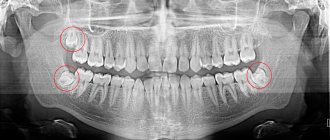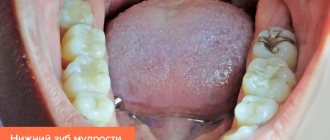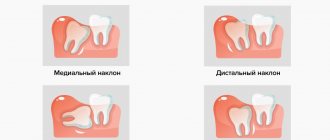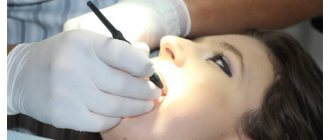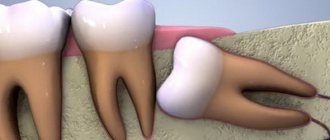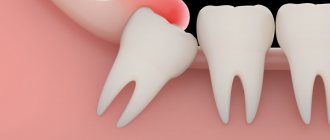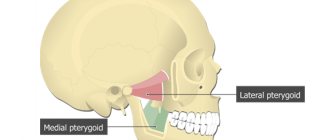Patients often experience fear before surgical treatment. This is completely natural and understandable. As a doctor, and simply as a person who also has to seek medical help, I completely share these feelings. That is why I want to talk in more detail about such a widespread procedure as the removal of third molars (wisdom teeth) in order to dispel a number of myths about this manipulation, and, I hope, help patients drive away unnecessary anxiety and properly tune in to treatment.
international experience
In different countries, the answer to the question: “Do you always need to remove wisdom teeth?” different. In the USA, 8s are removed already in adolescence, before they lead to problems, that is, they act according to a preventive scenario. In the CIS countries, if teeth erupt correctly and do not cause problems, they are left behind. Apparently this is due to the characteristics of healthcare models.
At the same time, many scientific works on this problem among conscript soldiers in the Russian Federation attract attention, and it is no coincidence. It is at this moment that wisdom teeth begin to actively grow and reveal previously hidden problems. And treatment often requires surgery.
Where do the folds come from?
Oral and maxillofacial surgeons and orthodontists are well aware of how wrinkles are associated with missing teeth. For example:
“Eights” , also known as wisdom teeth, were considered unnecessary for many years. They were never treated and offered to be removed even if they did not hurt. It turned out - and dentists recognized this - that “eights” are useful from the point of view of preserving youth. If they have grown, they act as an internal frame for the cheeks, and the removal of these teeth promises early vertical wrinkles on the cheeks and sagging of the lower part of the cheeks, the so-called jowls.
Questions and answers Why do teeth fall out?
Molars are the main support for the cheeks from the inside. If they are missing, the cheeks become sunken, and asymmetrically sunken. And depressions quickly lead to the formation of deep vertical wrinkles and strengthening of nasolabial folds. Following the loss of chewing teeth, the corners of the eyes droop, “crow’s feet” appear, and they are complemented by the same jowls and marionette lines—multiple branching folds running down from the corners of the lips, because of which the lower jaw appears to be attached to a hinge.
The canines , both upper and lower, are responsible for the curve of the lower line of the oval of the face - approximately along the edges of the lower jaw. If they are missing, the oval of the face loses its clarity, folds and sagging like a double chin form. The corners of the mouth droop, which gives the face a tired expression, and after them the nasolabial folds become stronger. The same jowls and marionette wrinkles may appear.
The absence of one or more front teeth leads to the recession of the upper or lower lip, which then transforms into wrinkles. Later, wrinkles in the area of the nasolabial triangle intensify, and sagging appears under the lower lip. The smile line goes down - now the corners of the mouth do not rise when smiling. Well, marionette wrinkles traditionally accompany the loss of a tooth, no matter where it is located.
Article on the topic
Insurance for an understudy. How to care for dentures
What is the diagnosis
Doctors often use 2 terms when describing problems with wisdom teeth.
Retention – when a tooth fails to erupt. It grew, but remained inside the jaw completely or partially. This can create a focus of inflammation, which either subsides or worsens again. But the most unpleasant consequence can be a cyst around the tooth if it has not erupted at all.
Dystopia is an abnormally positioned tooth, for example, horizontally. At first, such a tooth germ may not bother you at all. But when it starts to grow, it can lead to a lot of problems. You also need to remember that the tooth simultaneously grows in 2 directions towards the crown and towards the roots. If such a rudiment is tilted, then the tooth may appear from the side of the cheek or, conversely, grow inside the mouth and scratch the tongue.
One of the options for dystopia is a horizontal arrangement.
During the process of growth, a slightly inclined tooth in a narrow jaw can “catch” on the neighboring one, which will lead to an accident. The growing tooth will turn around and lie horizontally. Further, the growing tooth can gradually displace the remaining teeth and lead to crowding of the front teeth. This will create a new problem, not only an aesthetic one, but daily hygiene becomes more difficult and the risk of caries increases.
Often dystopia is combined with retention, which provides more reasons to remove problematic eights.
When to panic?
How long can you go without teeth before all these unpleasant consequences appear? Here you need to figure out what happens after tooth loss.
In the jaw bone there is a so-called tooth socket. If a tooth falls out, then the number of blood vessels in the area of its former root decreases - they are no longer needed. Following this, the bone tissue around the hole begins to dissolve, and instead of the hole, a dent forms. Then the jaw drops and becomes thinner in this place.
In youth, elastic skin and rapid cell renewal allow you to live 3-5 years before tooth loss is reflected in the form of wrinkles. But after 40 years, such wrinkles appear within six months to a year after tooth loss! It is difficult to say which is more dangerous - after all, while youth allows a person to avoid prosthetics, the jawbone is destroyed. So, at any age, it is advisable to restore a lost tooth within 3 months. Otherwise, there is a risk of aging outwardly earlier than nature should!
Risks
There are genetic features that do not change, but there are those that depend on various factors, including age.
Facial structure
One of the easiest ways to determine whether there is a greater or lesser risk of problems with wisdom teeth is through a mirror. Let's pay attention to the face. If it is elongated from bottom to top, has narrow cheekbones, and people say a small, neat face, then there may not be enough space for wisdom teeth. But the wider the cheekbones, the wider the “bone”, the more space there is for cutting figure eights.
Also, sufficient space in the jaw reduces their crowding and creates conditions for good hygiene. And this is the best prevention of caries, not only of the seemingly unnecessary tooth that we inherited from our ancestors, but also of all other teeth.
A consultation with an orthodontist and radiation diagnostics (X-ray/MRI) will help you understand the situation.
Age dependent
Problems that can arise with wisdom teeth at different ages can vary significantly2.
In youth, the main problem is inflammatory processes during the eruption of wisdom teeth. As well as the need to remove them for orthodontic treatment.
In adulthood, those who have retained their teeth begin to experience caries. The occurrence of pulpitis and cysts usually leads to a surgeon for removal.
In old age, the main problem is periodontal disease, which usually also leads to the removal of wisdom teeth. Or it becomes a preparation stage for prosthetics.
Is it possible to remove a molar tooth yourself?
Trying to remove a molar tooth yourself is extremely dangerous. The only exception is very severe tooth looseness. It should be borne in mind that complete removal even in this situation will not work. You will simply break off the body of the tooth from the root, and nothing more. In any case, after such an independent removal, you need to visit a dentist, who will determine what should be done next. Sometimes an artificial tooth is installed at the root, and it can last for more than one year. If the root has defects, then it has to be removed.
There are situations when you have to remove a child’s very loose baby tooth at home. In this case, you should thoroughly brush the baby’s teeth and disinfect the oral cavity. Then you should wrap your fingers in sterile gauze, loosen the tooth thoroughly, and only then try to pull it out. If this was not possible on the second attempt, then the child must be taken to the dental clinic in any case.
If you have successfully removed the tooth from the socket, then you must firmly place a gauze swab in the socket and leave it there for 30 - 40 minutes. In the next two hours, the child should not be allowed to eat or drink.
Even if the removal was successful, the baby still needs to be shown to the dentist. This is the only way to protect your child from possible complications.
Why is it so scary
Whether wisdom teeth need to be treated or removed immediately is not easy to decide. They are inconvenient to treat either for patients or for dentists themselves. The former “run out of steam” in the chair, trying to open their mouths wider, while the latter must show all their dexterity in order to reach the problem tooth. A dentist can even cure a difficult tooth, but the gum pockets around the gums can constantly become clogged with food, then the “carious monsters” again attack the tooth and all efforts are in vain.
If pulpitis occurs, rarely will anyone undertake root canal treatment. Roots in the amount of up to 5 pieces, adhesions, shapes in the form of hooks and squiggles, will become an impenetrable labyrinth for any speleologist dentist.
So, having suffered and spent N amount of money, many come to the logical result - “Delete!”
But removal can be just as scary as treatment. According to studies, complications occur after removal in more than 50% of cases3. They are often successfully treated, but add sick days and discomfort.
After wisdom tooth removal, there is a high probability of encountering complications.
Features of the eighth teeth
Wisdom teeth close the row of teeth on both sides. A highly qualified dentist is able to reach them safely and treat them. This will take more effort and time, but saving the organ is quite possible.
The difficulty of treating the canals of premolars and molars is explained by the frequent curvature of tooth roots and canals, and in addition to the fact that the patient is simply not able to open his mouth wide enough to provide the doctor with direct access to the affected area. Select people react acutely to such deep touches and show a predisposition to develop a gag reflex. Therefore, the doctor does not always treat wisdom teeth efficiently, hence the high percentage of complications in the treatment of dental pulpitis.
A person, when coming to an appointment, must understand - after consulting a dentist - that the decision to save a tooth will have to be made independently. The doctor will invariably receive his earnings - either by performing therapy or by removing the organ. The main thing is that his intervention brings benefit to the patient.
Should I delete or not?
Yes. If diseases or complications have already arisen. Or the situation with 3 molars creates a high risk of diseases and their complications. Such cases include:
- lack of space in the dentition. Crowding – deformity – malocclusion;
- incorrect anatomical position (dystopia). The tooth grows towards the cheek, tongue, throat. May damage mucous membranes and cause ulceration;
- installation of braces to correct the bite. Freeing up space for other teeth;
- destruction of a neighboring tooth. As the tooth grows, it can damage the adjacent molar;
- problems with eruption (retention).
No. The teeth are healthy, there are no problems and no problems are expected.
Special attention. Long business trips, pregnancy, any situations that limit the possibility of providing medical care. Before these events, it is better to get advice and assess the risks, because treatment often requires surgery.
Prevention
The right strategy, starting with teething, will help you worry less and reduce risks:
- Orthodontic consultation at a young age.
- The culture of brushing teeth using effective methods in hard-to-reach places, not only with a brush, but also:
- dental floss;
- irrigator;
- mono-beam brush.
- Preventive hygiene and examination
- Timely removal when problems are inevitable and it is better to prevent them than to treat the consequences.
The wisest decision regarding your health and wisdom teeth would be to visit a dentist in a timely manner. This will help protect you from problems and, most importantly, from consequences.
Literature:
- Iordanishvili A.K., Korovin N.V., Serikov A.A. ANATOMIC AND TOPOMETRIC CHARACTERISTICS OF THE JAWS DURING ERUPTATION AND RETENTION OF WISDOM TEETH // Problems of Dentistry 2022 No. 3.
- Iordanishvili A.K., Korovin N.V. et al. AGE FEATURES OF WISDOM TEETH DISEASES//Kursk Scientific and Practical Bulletin “Man and His Health” 2015 No. 4.
- Iordanishvili A.K., Korovin N.V. et al. COMPLICATIONS AFTER REMOVAL OF WISDOM TEETH AND THEIR TREATMENT//Kursk Scientific and Practical Bulletin “Man and His Health” 2022 No. 4.
Myth No. 1. Wisdom tooth removal is a difficult and painful procedure.
Let's start in order. Third molars do have a number of features. The anatomical structure of the tooth itself may be different. For example, one person's tooth will have four roots diverging to the sides, while another person will have only one straight root. In addition, the position of the tooth in the jaw is of great importance. The tooth can be located in the dental arch or located far beyond it (such a tooth is called dystopic). It can also be located inside the jaw (be impacted or impacted). Therefore, before proceeding with the removal, the dental surgeon will carefully study your X-ray image and think over the surgical technique. I hasten to reassure patients, there is a lot of domestic and foreign literature on this issue. Methods for removing teeth have long been developed and described depending on their structure and position. World experience (and my personal one) show that the effectiveness of this manipulation is 100%. The 7 Doctors clinic employs professional, experienced doctors. No matter how difficult the removal may seem to you, the success of this procedure is guaranteed.
So, we have sorted out the question that a tooth will be removed regardless of the “complexity” of its structure and/or position. But how will the patient feel during the operation, will he experience pain?
The answer is no, it won't hurt. Modern drugs used for local anesthesia in dentistry make it possible to completely reversibly (during the operation) turn off pain sensitivity. The sensitivity of the surrounding tissues (in the area where the operation is not performed) is preserved, so the patient will feel the touch of the doctor’s hands, some pressure on the surrounding tissues, but no more.
In some cases, when the fear of the procedure is so great that a person cannot cope with it, we recommend contacting a psychotherapist. A specialist will help you get rid of this problem, and you will be able to continue treatment in a comfortable environment. However, there is an alternative: tooth extraction under anesthesia. This option is also used if the patient has contraindications to local anesthesia (for example, an allergic reaction to local anesthetics).
In any case, there is a way out. Our clinic employs a team of professionals from various specialties. Doctors at the multidisciplinary clinic “7 Doctors” will always find an individual approach to solving your problem.

